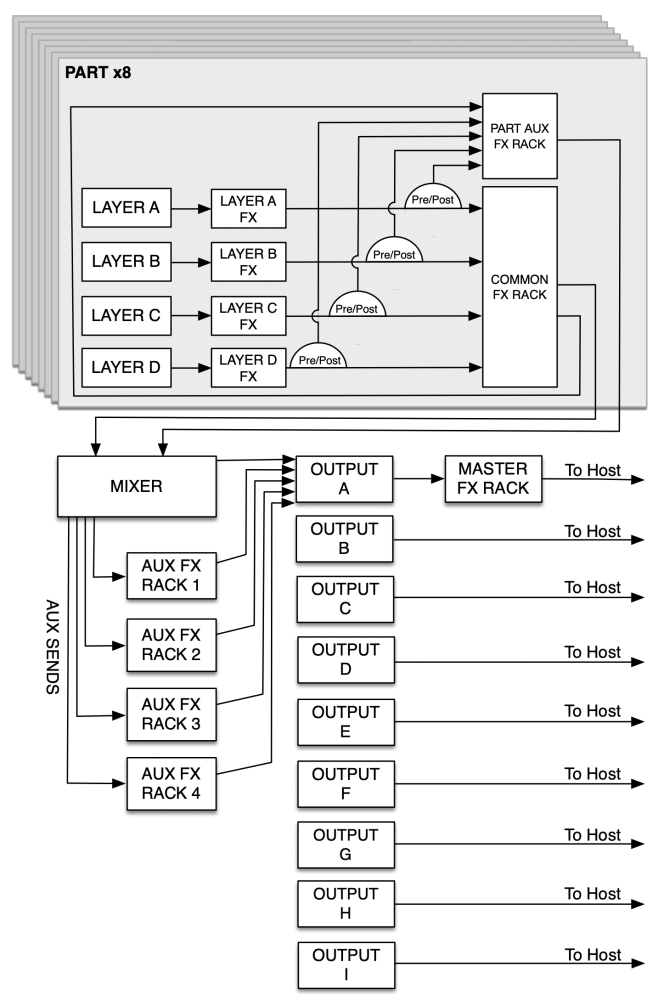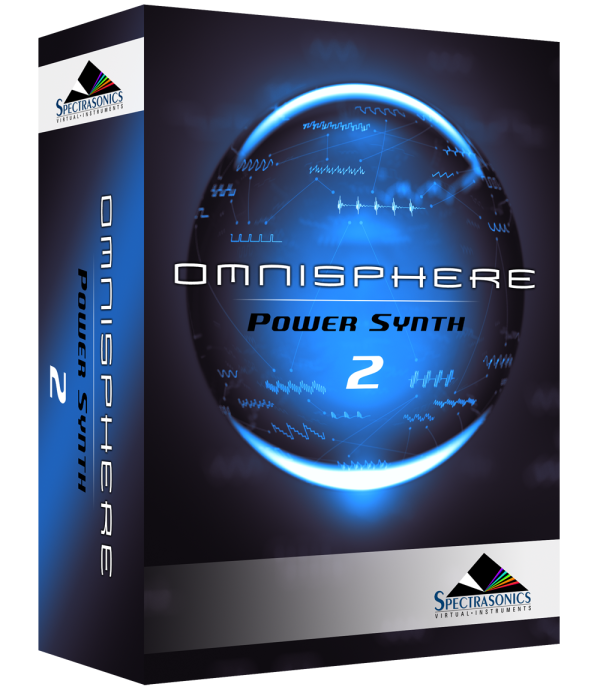In Omnisphere there are two main types of FX racks: those that work within a single Part and are saved with a Patch (Part FX Racks), and those that are shared by multiple Parts and saved with a Multi (Multi FX Racks).
PART FX RACKS
Using effects units, ranging from simple EQ and dynamics processors to creative effects chains, can be a crucial ingredient of any Patch in Omnisphere. To access the FX Racks for a Part, select a Part in the header and then select the FX button.
There are three types of FX racks in a Part: LAYER, COMMON, and AUX.

LAYER FX RACKS
Each Omnisphere Part contains four Layers, and each Layer, depending on the Signal Path mode, can have an independent FX rack.
When a Part’s Signal Path is set to “Independent,” each Layer in a Part has its own Layer FX rack, which is pre-Layer Level. This setting is the most powerful and flexible for sound design, since it allows each of the four Layers to be processed through an independent FX chain.
When a Part’s Signal Path is set to “Shared,” all Layers are run through a shared single Layer FX rack that is post-Layer Level. This setting is more CPU friendly, and while it is more limited, it still gives you plenty of sonic possibilities since it allows all Layers to be processed through up to 8 insert effects (Layer FX Rack + Common FX Rack).
Before the Layer Racks feed the Common Rack, their output can be sent to the Part Aux Rack via the Aux Send mini-slider.
Using the Layer FX Rack Aux Sends
The Layer Rack Aux Send mini-sliders and PRE/POST switch are used to send signal from the output of the Layer FX Rack to the Part Aux Rack.

When set to POST, the amount of signal sent to the Aux Rack is relative to the Layer Level: if the Layer Level is turned down to zero, no signal will be sent to the Part Aux Rack. This setting allows the proportion between the original signal and the one sent to the Aux Rack to remain constant.
When set to PRE, the Layer’s signal is sent to the Aux Rack before the Layer Level fader on the Layer Page. This means the signal sent to the Aux Rack will remain constant based on the Aux Send level, regardless of the setting of the Layer Level. This setting is most useful when you want to hear the signal processed by the effects in the Aux Rack without hearing the original.
NOTE: The Pre/Post switch has no effect when the Signal Path is set to “Shared,” and it always works in POST mode.
COMMON FX RACK
Every Layer’s signal is fed into the Common FX Rack, so effect units inserted in the Common FX Rack affect all Layers. The Common Rack can use its “AUX SEND” mini-slider in the top right to send audio to the AUX rack. Both the Common FX Rack and the Part FX Rack feed the Part Output.
AUX FX RACK
Effects units in the Part Aux Rack can receive signal from the Layer Racks and the Common Rack via their respective Aux Send faders. The Aux Rack feeds into the Part Output and its output level is controlled by the Aux Return mini-slider. This rack is most commonly used for adding ambience processors, such as reverbs and delays.
With a total of 24 available FX units in each Patch, you have tremendous flexibility in utilizing and routing Omnisphere’s extensive collection of FX.
MULTI FX RACKS
A MULTI in Omnisphere has four Aux FX Racks and a Master FX Rack. Multi Aux FX racks can be useful for sharing the same reverb or delay across multiple parts through the Mixer Aux Sends, which can help optimize your computer’s resources. The Master FX Rack is the final FX rack in Omnisphere’s signal path and is useful for adding EQ and dynamics processors that affect all parts.
You can access the Multi FX Racks by selecting the MULTI tab in the header and then selecting the FX button.
NOTE: The Master FX Rack processes the Multi Aux FX Racks and all parts that are routed through output A. Parts assigned to outputs B-I are not processed by the Master FX Rack.
In summary, a MULTI can have up to 20 FX Units loaded in the MULTI FX racks, plus 8 Parts containing up to 24 FX Units each. This means a fully-loaded MULTI can have as many as 212 active FX Units if all 53 Racks are loaded at once. Of course, actually running that many simultaneous FX would require a very powerful computer!
Below is a diagram of the FX Signal Path which shows how Omnisphere’s FX are chained.

Need more help with this?
Spectrasonics Customer Support



